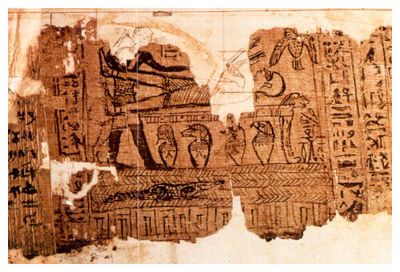
FAIR is a non-profit organization dedicated to providing well-documented answers to criticisms of the doctrine, practice, and history of The Church of Jesus Christ of Latter-day Saints.
| Line 61: | Line 61: | ||
[[File:Abraham.lion.couch.jpg|thumb|400px|left|Photo appearing in John Gee, [http://www.lds.org/ldsorg/v/index.jsp?hideNav=1&locale=0&sourceId=975594bf3938b010VgnVCM1000004d82620a____&vgnextoid=2354fccf2b7db010VgnVCM1000004d82620aRCRD “Research and Perspectives: Abraham in Ancient Egyptian Texts,”] Ensign, Jul 1992, 60 Caption "A lion couch scene appears in Leiden Papyrus I 384 (PGM xii). The outline marks Abraham’s name, written in Greek. (Courtesy of Rijksmuseum van Oudheden.)" (click to enlarge)]] | [[File:Abraham.lion.couch.jpg|thumb|400px|left|Photo appearing in John Gee, [http://www.lds.org/ldsorg/v/index.jsp?hideNav=1&locale=0&sourceId=975594bf3938b010VgnVCM1000004d82620a____&vgnextoid=2354fccf2b7db010VgnVCM1000004d82620aRCRD “Research and Perspectives: Abraham in Ancient Egyptian Texts,”] Ensign, Jul 1992, 60 Caption "A lion couch scene appears in Leiden Papyrus I 384 (PGM xii). The outline marks Abraham’s name, written in Greek. (Courtesy of Rijksmuseum van Oudheden.)" (click to enlarge)]] | ||
Critics claim that Abraham would never be associated with the Egyptian "lion couch" scene. Recently, however Abraham's name has indeed been discovered associated with one such "lion couch" scene. {{ref|gee.ensign.60}} | Critics claim that Abraham would never be associated with the Egyptian "lion couch" scene. Recently, however Abraham's name has indeed been discovered associated with one such "lion couch" scene. {{ref|gee.ensign.60}} | ||
<videoflash>f69rSirKWXs</videoflash> | |||
{{SectionUnderConstruction}} | {{SectionUnderConstruction}} | ||
Contents
|

== Critics make the following claims regarding Facsimile 1:

The papyrus with the illustration represented in Facsimile 1 (view) is the only recovered item that has any connection to the text of the Book of Abraham.
This vignette is called a "lion couch scene" by Egyptologists. It usually represents the embalming of the deceased individual in preparation for burial. However, this particular lion couch scene represents the resurrection of Hor (figure 2), aided by the Egyptian god Anubis (3).[1]
Abraham 1:12 and the notes to Facsimile 1 identify it as representing Abraham being sacrificed by the priest of Elkenah in Ur.

Although many similar lion couch scenes exist, this one has quite a few unique features:

Joseph interpreted this figure to be "The idolatrous priest of Elkenah attempting to offer up Abraham as a sacrifice." This figure is normally represented in lion couch scenes as having the jackal head of Anubis. If the portion of the priests head was indeed missing at the time that the facsimile was copied prior to its publication in the Times and Seasons, it may have been restored simply by copying the head of the figure lying on the lion couch. Unlike standards that would be following in publishing today, it was not considered acceptable at that time to publish a figure with missing gaps.
Joseph correctly interpreted the figure as a priest. Whether the priest has a human head or is wearing the mask of Anubis makes no difference to the interpretation.
Critics insist that this scene should contain two birds. However, not all lion couch images contain two birds.

With relation to the claim that a missing portion of Facsimile 1 contained a second bird, the partial figure interpreted as Abraham's second hand is claimed to actually be a portion of the wing of this bird.

Compare the disputed figure with the wing of the existing bird. Note that they are not drawn in similar styles. Also note that the Egyptians drew elongated thumbs. The disputed figure shows such a thumb. The Egyptians had distinct styles for drawing hands and drawing wings.

| This section of the article is still under construction. We welcome your suggestions for improving the content of this FairMormon Answers article. |

Critics claim that Abraham would never be associated with the Egyptian "lion couch" scene. Recently, however Abraham's name has indeed been discovered associated with one such "lion couch" scene. [2]
<videoflash>f69rSirKWXs</videoflash>
| This section of the article is still under construction. We welcome your suggestions for improving the content of this FairMormon Answers article. |
==

FAIR is a non-profit organization dedicated to providing well-documented answers to criticisms of the doctrine, practice, and history of The Church of Jesus Christ of Latter-day Saints.
We are a volunteer organization. We invite you to give back.
Donate Now